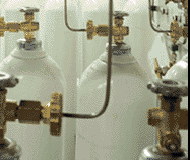Hospitals eTool
Central Sterile Supply » Compressed Gases

Within a healthcare facility, compressed gases are usually found in either fixed piped gas systems or in individual cylinders.
Hazards
Potential hazards associated with compressed gas will vary based on the chemicals; however, they may include fire, explosion, and toxicity.
Recognized Controls and Work Practices
- Store, handle, and use compressed gases in accordance with 29 CFR 1910.101(b) and Pamphlet P-1-1965 from the Compressed Gas Association. Comply with all provisions of 29 CFR 1910.101.
- Store all cylinders, whether empty or full, in an upright position.
- Secure cylinders of compressed gases. Never drop cylinders or allow cylinders to strike each other with force.
- Transport compressed gas cylinders with protective caps in place and do not roll or drag the cylinders.

Additional Information
- 29 CFR 1910.101, Compressed gases. OSHA Standard.
- 29 CFR 1910.103, Hydrogen. OSHA Standard.
- 29 CFR 1910.104, Oxygen. OSHA Standard.
- 29 CFR 1910.105, Nitrous oxide. OSHA Standard.
- Compressed Gas and Equipment. OSHA Safety and Health Topics Page.
- NFPA 99, Standard for Health Care Facilities, Chapter 4, Gas and Vacuum Systems. National Fire Protection Association, (2005).
- U.S. Food and Drug Administration: Compressed Medical Gases Guideline

